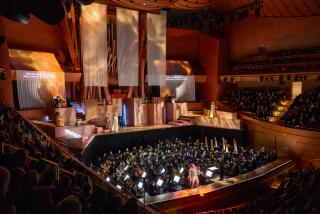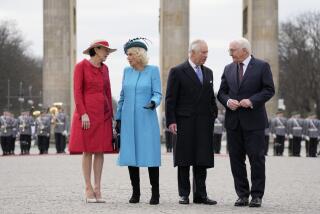Bavaria: King Ludwig Jubilee Year
- Share via
MUNICH, West Germany — Fairy-tale king, mad monarch, builder of dream castles, patron of Richard Wagner. King Ludwig II was all of these personalities and more, but that’s only the beginning of what the King Ludwig Jubilee Year of 1986 can add to the many rewards of travel in Bavaria.
This year commemorates the legacies of two former Bavarian kings: Ludwig I, born 200 years ago, and Ludwig II, whose death by drowning 100 years ago still raises the kind of questions that would intrigue the talents of mystery writer Agatha Christie.
However, this jubilee year could reach back further into the history that enriches the contemporary travel experience.
Both Ludwigs, grandfather and grandson, were part of the royal Wittelsbach family that established the Bavarian dynasty in 1190 and ruled until 1918. From palaces in and around Munich, these rulers created the architectural and cultural setting that will draw more than 500,000 visitors this year.
Series of Events
From June through December, festivals, open-air concerts, opera balls, museum exhibitions, parades, gala banquets and tours of the dream castles will be offered throughout Bavaria.
As early as the 14th Century, the Bavarian Emperor Ludwig imported many of Europe’s finest designers and architects to establish the foundation of what Munich is today.
Three Ludwigs were Holy Roman emperors. Their names and numerical designations within changing dynasties sometimes seem out of historical sequence, Ludwig in German, Louis in French. A Wittelsbach ruled the Holy Roman Empire into the early 15th Century as Louis IV.
The Ludwig I commemorated in this year’s jubilee wanted his city to be a jewel in the heart of the Continent. He brought designers from Italy in the 19th Century to establish the ambiance of classical architecture that still sets the mood of the city.
If you can take the time to tour Munich in depth this year, you’ll discover that Ludwig I was almost as complex a character as his more famous grandson with whom he shares the jubilee. He was a scholar, patron of the arts, builder of museums. One of his architectural legacies to Munich was the Koenigsplatz square of historic buildings. Politically, he was a moderate in his younger years and a reactionary after the revolutionary spirit spread from France to the rest of Europe.
He was also a romantic who refused to give up his mistress, the beautiful British dancer Lola Montez, and finally abdicated to live most of the rest of his life in France.
Much of the attention this year, as it has for the past century, will go to Ludwig II, who became King of Bavaria in 1864 at age 18 and ruled until just before his mysterious drowning in 1886.
Highlights of Travels
The dream castles he built as the fairy-tale king will be highlights of Jubilee Year travels around Bavaria. Neuschwanstein, built in 1868, is likely the most photographed castle in the world, and is the model for Walt Disney’s Fantasyland castles at Disneyland and Disney World.
Its five towers rise 200 feet above a deep mountainside gorge. From balconies of the Throne Room, the young king could look out over the lakes and mountain views of the Bavarian countryside. The style of the castle is late Romanesque of the early 13th Century.
This fantasy wasn’t yet completed when Ludwig began building his second dream palace near Oberammergau, where the Passion Play staged its 350th anniversary two summers ago. We were there that summer for the play and afterward visited Ludwig’s Linderhof Palace.
Ludwig borrowed ideas for its rococo grandeur from Louis XIV, the French “Sun King.”
Beyond the palace grounds is Germany’s largest national park, with species of flowers and plants that date glacial times. Trails and bicycle paths weave in a scenic network that could take days to explore. Rock climbers scale the mountainsides; hang gliders take off from the cliffs.
One road and set of trails leads to the high Gothic architecture of the abbey at Ettal and the Benedictine monastery founded by Emperor Ludwig in 1330. Close to Linderhof is a grotto of stalactites and stalagmites with an artificial lake built for Ludwig II. He enjoyed floating there on a gilded skiff, listening inwardly to Wagner’s music. Sometimes he boarded the skiff dressed as Lohengrin from the Wagner opera.
Then came his third castle, the Palace of Herrenchiemsee, built on a deserted island in the middle of Lake Chiemsee and styled after Versailles. From one vaulted ceiling hang 33 crystal chandeliers. The hallway can be illuminated by nearly 3,000 candles in 44 gilded candelabra. Concepts of space and time are lost within the gallery of mirrors.
Career of Wagner
While he was building his dream castles, Ludwig II also was underwriting the career and life style of Richard Wagner, whose music he idolized. At a financial low point along his storm-swept road to immortality, Wagner came to the Bavarian city of Bayreuth to find a setting for his happiest and most successful hours.
With financial help from the young emperor, he constructed his home called Wahnfried, an architectural masterpiece that is a museum for visitors. He also built the Festival House, a one-of-a-kind opera house where his works have been performed each summer for more than a century. At Wahnfried, Wagner created such operatic masterpieces as “Tannhauser,” “Lohengrin,” “The Flying Dutchman,” “Tristan and Isolde,” “Parsifal,” “Die Meistersinger.”
But a new Europe was being born with the industrial age. The people of Bavaria, who had to carry the financial burden of Ludwig’s dream palaces and patronage of artists, were becoming restless with his autocratic rule.
The people laughed without humor in village taverns over the extremes to which King Ludwig would go to preserve his privacy by keeping his servants as invisible as possible, such as by having his dining table lowered through a trap door into the kitchen where it could be set by servants who remained out of sight.
Body Found in Lake
Powerful nobility within and around the ruling monarchy finally had Ludwig declared insane by a group of physicians, who then took him to Berg Castle at Starnberg Lake. Within a week after being deposed he was found drowned in the lake. The official explanation was suicide, but there were many who never believed that.
You can plan self-guided tours to relive these and many more stories. Within Munich, a streetcar ride to the western edge of the city leads to Schloss Nymphenburg, the baroque summer palace of the Wittlsbachs with one of the finest royal gardens in Europe. Marble statues of Roman gods line the Grand Canal on which members of the royal court once glided on gondolas brought from Venice.
The Residenz winter palace is in the center of the city, where the Treasury contains the Bavarian crown jewels.
This and many sights provide a perspective on walks through the city this year, from the Rembrandts and other masterpieces in the Alte Pinokothek Museum to the jousting tournament re-created on the Town Hall tower at 11 a.m.
Make a note, too, that the 150th anniversary of the steam train in Bavaria didn’t end last year. The historic train reconstructed for the anniversary year proved so popular that it will continue to carry passengers between Nuremberg and Bayreuth.
For more information, contact the German National Tourist Office, 444 S. Flower St., Los Angeles 90071, phone (213) 688-7332).
More to Read
Sign up for The Wild
We’ll help you find the best places to hike, bike and run, as well as the perfect silent spots for meditation and yoga.
You may occasionally receive promotional content from the Los Angeles Times.






